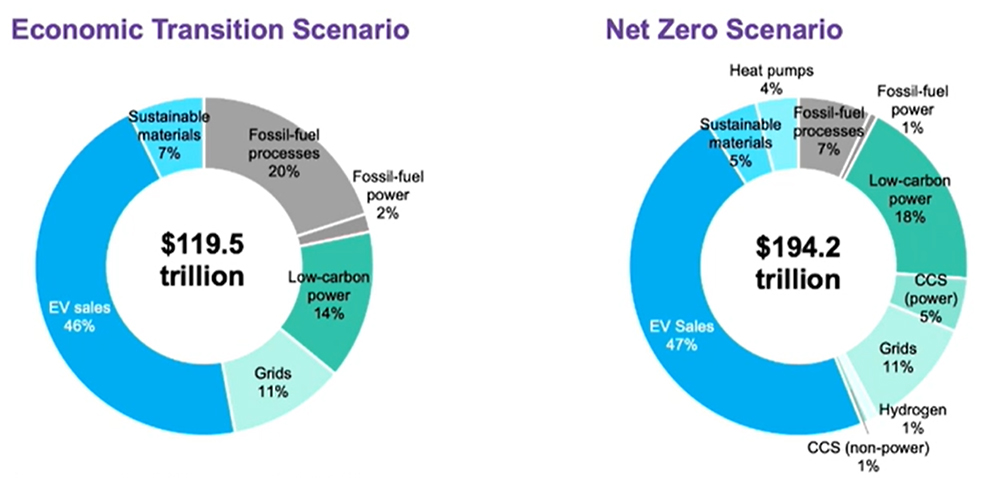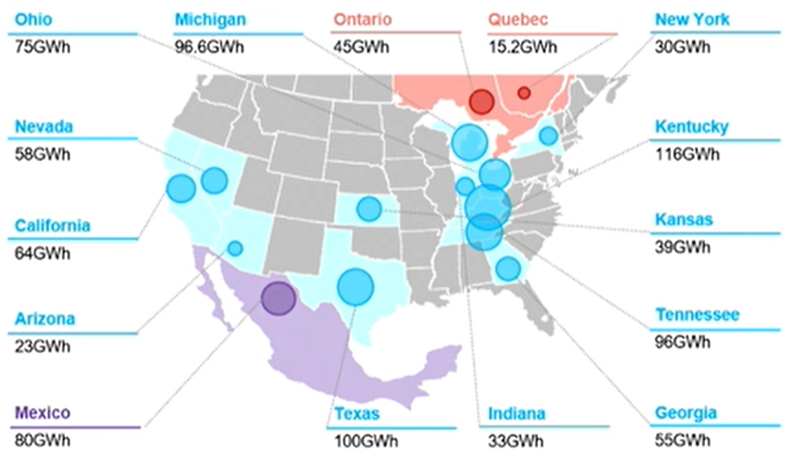
Of the $194 trillion in investments that BloombergNEF projects will be needed for the world to even get close to limiting climate change to 1.5 degrees Celsius by 2050, 47% will be targeted at electric vehicle sales, according to BNEF CEO Jon Moore.
Transportation electrification is the key theme at the two-day BNEF Summit in San Francisco, and Moore opened the event on Monday with a rundown of the numbers its analysis shows will be driving the transition, whether it is based purely on economics or on the 2050 net-zero targets set by the 2015 Paris Agreement.
 BNEF CEO Jon Moore | BNEF
BNEF CEO Jon Moore | BNEF
“Assuming we chose the most economic solutions … that gets us to 2.6 degrees, so not in line with Paris,” Moore said. Based only on targets, “we can actually bend the curve to about 1.77; so not to 1.5, but 1.77.”
Similarly, according to BNEF’s 2022 New Energy Outlook, greenhouse gas emissions from transportation could peak in 2024 in a net-zero scenario, versus 2028 in the economic scenario.
Moore’s numbers showed other significant gaps between BNEF’s economic transition scenario (ETS) and its net-zero scenario (NZS). For example, a transition based on economics would generate $119 trillion in investments — about 33% less than $194 trillion for net zero — with again almost half going to EV sales.
Either way, he said, “the scale of investment required, literally in the next 30 years, will be huge.” Moore sees encouraging signs in the $466 billion in investment that transportation electrification snagged in 2022, which was “up 54% year on year, which is … pretty amazing.”
Passenger vehicles drew the lion’s share of those dollars, and will continue as a major factor, he said, adding that more than 10 million EVs were sold globally last year. They will also account for more than half of EV battery demand, which could total as much as 6.6 TWh by 2035 in the NZS, Moore said. BNEF see similar, dramatic growth in lithium demand, reaching 5.9 million metric tons by 2035 — an 18-fold increase over 2020.
 EV sales will account for almost half of all climate investments over the next decades, whether in an economic or net-zero transition. | BNEF
EV sales will account for almost half of all climate investments over the next decades, whether in an economic or net-zero transition. | BNEF
“So, lithium will become absolutely key as an enabler and as a potential bottleneck in the transition,” he said.
The Inflation Reduction Act could at least jump-start the supply chain buildout needed to meet that demand. BNEF has tracked more than $27 billion in supply chain investments since the law was passed, with about 60% of that total going toward EV battery plants.
But, Moore said, those figures do not include Tesla’s recent announcement of its plans for a $3.6 billion plant in Nevada. (See Tesla to Invest $3.6B in Nev. Truck, Battery Factories.)
One interesting point, Moore said, is that in the NZS, EV battery demand peaks in 2035, not 2050, “because if you want to, by 2050, decarbonize your fleet, you really have to be selling a decade or so earlier.”
Aviation is Hydrogen’s Sweet Spot
Moore framed BNEF’s figures as the company’s attempt to cut the “noise” in energy analysis — that is, the biases and errors in judgment that can skew figures.
Minimizing that noise — with extensive research and algorithms — is “really important because we’re going to spend tens, hundreds of trillions on the energy transition,” Moore said. “Every error in judgment that we make, every deviation from how the world progresses, is either an underinvestment or an overinvestment, so it’s actually very expensive.”
Disagreement is inevitable, he said, but “the idea is to bring down the cone of disagreement.”
“Economics alone won’t get us to net zero,” Moore said. “We’re going to need to bend the curve somehow, and policy is going to be one of the ways that we will do that.”
Policy could be critical in increasing the amount of clean power on the grid, as BNEF is anticipating that carbon-free electricity will account for just over one-half of the GHG emissions reductions needed to keep climate change to 1.77 C.
Wind and solar account for 65% of global power supply by 2050 in the ETS, versus 76% in the NZS, Moore said. Green hydrogen, bioenergy and carbon capture will play smaller but significant roles, together providing about 20% of emissions reductions by 2050, he said.
 The IRA has triggered a wave of new investment in a North American EV supply chain. | BNEF
The IRA has triggered a wave of new investment in a North American EV supply chain. | BNEF
The IRA could have a significant impact here as well, by stimulating “a lot of different technologies,” Moore said. BNEF sees the law’s clean energy incentives expanding solar from about 40,000 GW to 50,000 GW by 2030, and wind from 25,000 GW to 35,000 GW.
The use of green hydrogen will also grow, Moore said, but BNEF sees aviation as its main market, followed by shipping and then transportation.
Hydrogen use in aviation will be for “short and medium haul,” he said. “For long haul, there will be biofuels and synthetic kerosene.
“For shipping, it will be ammonia and methanol from hydrogen, and on the road, it’s about 10% of [heavy-duty vehicles] and 15% of buses,” he said.
But BNEF sees hydrogen and electricity as complementary — with each serving different sectors — as opposed to competing. Aviation, shipping and steel will be “hydrogen-centric,” Moore said, while buildings, roads and other industries will be “electricity-centric.”



